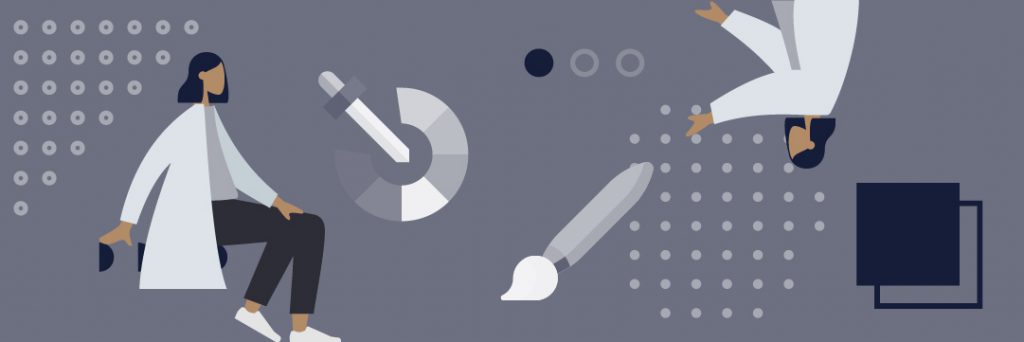Graphic design involves so many components, and color choice is a major one for effectiveness, cohesiveness, and aesthetics. With the use of a color wheel, you can incorporate just the right colors for your design, but first, it’s always helpful to have some learn some basics (and not so basics) of the color wheel.
What Actually is the Color Wheel?
In basic terms, a color wheel is a visual representation showing how colors relate to each other. Or as this article tells us, The color wheel is a chart representing the relationships between colors. You’ve seen it. Maybe you learned about it in elementary school art class, or maybe you spend tons of time creating on your computer using a color wheel. Whether it’s been on a document choosing a font color, at the paint store choosing paint colors, or working on a design to choose a perfect palette, you’ve seen the color wheel.
So how does it work?
The way the color wheel works is that it helps you choose colors that work well and complement one another. The color wheel makes it easy for us because of the color placement. But first, it’s important to know some color terms. Let’s take a brief look at some of the important terms with the help of worqx.com.
Primary colors – These are the colors at their basic essence and they cannot be created by mixing others. They are red, yellow, and blue. All colors come from these.
Secondary colors – These are the colors you get when you mix together two primary colors. Red and yellow make the secondary color orange, blue and yellow make the secondary color green, and red and blue make purple. Each color will have a specific placement on the wheel.
Tertiary colors – Yep, you guessed it. These colors are what you get when you mix primary colors with secondary colors. These are red-orange, yellow-orange, yellow-green, blue-green, blue-violet, red-violet.
Complementary colors – These colors are located opposite each other on the color wheel, think opposite colors, like red and green.
Analogous colors – These colors are located close together, like red, red-violet, and purple. They make a color family and can be very visually appealing when put together.
Now you know the basic color terms, but again, how do they work on the color wheel? The way the placement of colors is on the color wheel lets you see them with coordinating colors. Each primary color is evenly spaced and is across from a complementary color and nearby analogous colors. If you’re looking for strong contrast, choose colors on opposite sides of the wheel, but if you’re looking for a harmonious smooth look, choose analogous colors. Seems simple, right? Well, it is. And it’s not.
It’s not just a matter of choosing colors, but they should match the message you are trying to convey. Colors and color schemes can deliver specific vibes and messages, so it’s important to match them to your brand or aesthetic.
The Importance of Color When Sharing a Message
Color speaks volumes. Think about it – if you have a message to share and you present it in a gentle, analogous color scheme it’s going to present a different vibe than if you use bold, complementary colors. So whether you want a soothing feel or a bold, conceptual look, turn to color for your final details.
99 Designs shares some interesting insight on colors and branding – check this out:
Color theory goes a lot deeper than “pink is a pretty color.” Psychologists link it to the very evolution of humans; connections with certain colors developed after years of associating them with particular objects. A blood red, for example, puts people on alert for danger nearby; the browns of dirt and rotten food tend to be unappetizing.
This isn’t always accurate—after all, farmers (and chocolate lovers) might love the color brown, and let’s not forget humans evolved to see the color blue only in recent millennia—but when considering millions of years of biological conditioning, it’s easy to see how affiliations to colors goes beyond mere preference… something humanity has known for quite some time now.
Color association
So sure, colors can have different meanings for different people, but overall, here are some common feelings and meanings people associate with color:
- Red – Red can command attention and often stands for passion, love, and energy. Sometimes it conveys anger, excitement, and importance.
- Orange – Orange is another exciting color, but in a more playful and daring way. Orange represents playfulness, energy, and an invigorating, adventurous vibe.
- Green – Green is a color often associated with nature or affluence.
- Dark Blue – The dark blue tones of the color wheel make people think of security and trustworthiness. It also projects a tone of formality.
- Pink – Pink tones can stand for anything from youthfulness to fun to sensuality to femininity. This color depends a lot on the shade and what other colors you pair it with.
- Gray – Gray has made its mark in the world. It’s a great neutral that can evoke soothing calm feelings or mysterious, serious moods.
You can see, the colors of the wheel have a lot of different emotions they tend to evoke. Also, the pairings, or lack of pairing is very important. Here’s an example – if you have a serious, formal, professional design, dark blue paired with gray, may be a great palette. On the other hand, if you pair a different blue with a soft green, you’ll get a great natural, authentic, fresh vibe.
Wait – There’s More
So we’ve mentioned primary, secondary, and tertiary colors. We’ve also touched on some emotions that colors can evoke and some pairing of colors. But there’s more that the color wheel offers.
Warm and cool colors are also indicators of moods and vibes. The color wheel is helpful for identifying these, too. Warm colors are on the right side of the wheel and are the reds, oranges, and yellows. Because they remind of us fire (thus warmth) they are often energetic and bold. They also tend to project and stand out in design. On the other hand, the cool colors are on the left side of the wheel and are the purples, blues, and greens. These are the more gentle, soothing colors, think water and grass. They are a bit more passive and gentle in design.
Two Types of Color Wheels
Which type of color wheel you decide to work with will depend on the product you are creating. If you’re looking to paint your walls or create a t-shirt, use the CMYK wheel. This one uses cyan, magenta, yellow, and black which are the primary colors of printing.
If you are working virtually, you’ll use an RGB color wheel. No, we’re not talking about Ruth Bader Ginsberg here; RBG stands for red, green, and blue which are the primary colors of light and what computer screens use in their displays. The interesting thing here is that if you combine these three colors, you get white, and if you remove them all, you have black. It’s all about how the light works on a screen and the mixing of these three colors with hues and saturation. So if you want to design a website, for instance, you’ll use that virtual RBG color wheel.
Using the Color Wheel for Effective Color Combination
Since we’re talking websites, let’s talk about effective color combinations and using the color wheel to choose them. Some of the first things to think about are your audience, purpose, and brand. Here are some tips on using the color wheel for color choice, such as:
- Look beyond your favorite colors and choose colors to strengthen the website and your brand.
- Colors that work well individually may not be as pleasing when you combine them. Check the color wheel before doing so.
- Use the color wheel when deciding to go analogous, complementary, or monochrome.
- The more appealing your website is, the more engagement you’ll get. Color plays a big part in this.
- A monochrome color scheme doesn’t mean just one color, it can have multiple shades of one color. The RBG color wheel can help you find them.
Working On Your Own or With a Professional
Some people love to work on color design. For others, they’d rather pass it on to a professional. Whichever is your cup of tea, take some time to get ideas on how your project will resonate with your audience and which aspects of the color wheel you want to use. Our Bunny Studio designers would love to help in any design project you have, and we can turn your vision into a colorful site with effective design. Whether it’s your logo, your website, or any other aspect of your brand or marketing, we can have you covered at Bunny Studio, or use these tips and see what you can come up with!
Summing Up the Color Wheel
You may have learned about the color wheel way back in elementary school, but it does have great merit in design. The color wheel can help you define your marketing endeavors and create amazing visual graphics. We understand the use of color and how it plays into sending messages. The right colors can turn up your projects into works of art, but beware of the wrong color scheme, it can just be…well…wrong.











